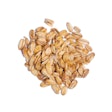
Regenerative agriculture can result in economic and environmental benefits for poultry operations, but it requires a clear sustainability strategy for success.
Advocates of regenerative agriculture define it as a set of farming and grazing practices that help to reverse climate change through the rebuilding of soil organic matter and the restorage of soil biodiversity.
A four-step roadmap can help poultry operations determine if regenerative agriculture is right for them, Nancy Himmelfarb, principal, Himmelfarb Sustainability Consulting, explained during “Regenerative Agriculture 101: A Beginner’s Guide” at the 2025 Annual Meat Conference.
1. Address farmer needs
Adopting new farming practices like regenerative agriculture isn’t always easy and it’s not risk-free, despite any potential benefits. Consumer behavior and trends change quickly, so it may feel like expectations are constantly changing, especially when it comes to things like sustainability, Himmelfarb said.
It’s important to evaluate farmer needs, create a business case and set a plan that provides farmers with technical and financial support before transitioning to regenerative agriculture.
2. Assess strategic fit
Next, decide if regenerative agriculture aligns with your company’s strategic values and point of view.
Consumers are increasingly choosing to purchase brands and poultry products that align with their values, so there may be financial incentive to adopting more sustainable practices, although regenerative agriculture does require a greater investment on the farmer side than traditional practices.
3. Tackle low hanging fruit
Investing in regenerative agriculture doesn’t have to be all or nothing, said Himmelfarb.
Begin by tackling the low hanging fruit. Figure out what’s easiest to change or that will make a major impact. That could be as simple as tweaking packaging or finding a new use for poultry manure as fertilizer.
4. Create a new narrative
Finally, make sure you get credit for the changes made by telling your sustainability story. Being transparent is important, but be sure to communicate simply, without technical jargon, that will confuse consumers.



















